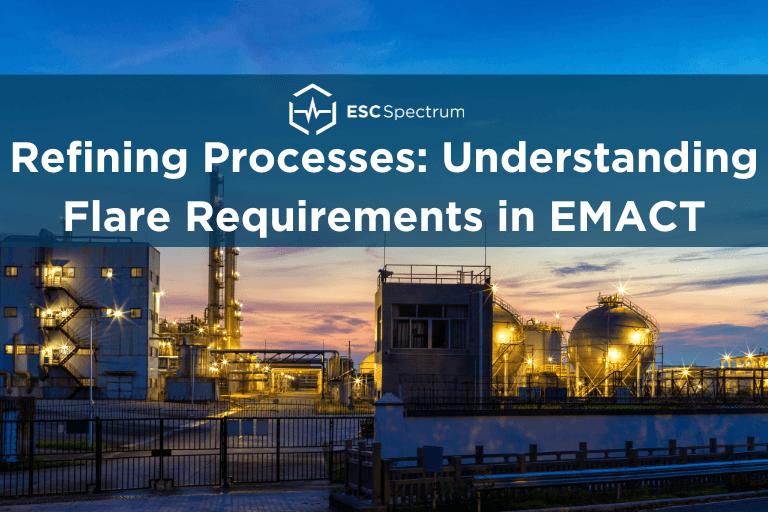What is Flaring in Refining Processes?
Flaring is a high-temperature process used to burn waste gases that contain flammable components like volatile organic compounds, natural gas, carbon monoxide, and hydrogen. These gases are sent to a remote location, typically elevated, where they are burned in an open flame using a special burner tip. Auxiliary fuel and sometimes assist gases like steam or air are used to ensure nearly complete (98% or more) destruction of the combustible components in the waste gas.
Want a deeper dive into more general flare monitoring under subpart SS? Read our blog post, “Decoding the World of Flare Gas Monitoring.”
Keep reading below to discover flare monitoring requirements for ethylene manufacturing plants.
What is EMACT?
The Ethylene Maximum Acheivable Control Technology (EMACT) rule was issued along with several other MACT rules as part of the existing Part 63 Subpart YY Generic MACT rule. A new Part 63 subpart (Subpart XX) was simultaneously issued and contains the requirements for ethylene process wastes and heat exchange systems.
The Ethylene MACT (EMACT) standard is designed to control emissions of organic hazardous air pollutants (HAPs) from ethylene manufacturing processes. The applicable organic HAPs are:
- Benzene
- 1,3-Butadiene
- Cumene
- Ethyl benzene
- Hexane
- Naphthalene
- Styrene
- Toluene
- o-Xylene
- m-Xylene
- p-Xylene
For more details on the Ethylene MACT, visit the EPA website to review the EMACT Compliance Manual.
The Role of Flares in Ethylene Manufacturing
Flares are critical control devices used in the ethylene manufacturing process to combust waste gases. They play a vital role in ensuring that hazardous air pollutants are effectively destroyed before they are released into the atmosphere. The Environmental Protection Agency (EPA) has set forth detailed requirements to ensure that flares operate efficiently and reduce emissions to the lowest possible levels.
Key Flare Requirements in Subpart XX and YY
The specific requirements for flares are outlined in § 63.1095 and include the following:
1. Design and Operation
- Flares must be designed to achieve complete combustion of HAPs, ensuring a destruction efficiency of at least 98%.
- A continuous flame must be maintained at all times when emissions are vented to the flare.
- The flare system must be equipped with an automatic re-ignition system to ensure continuous operation.
Ensuring Effective Combustion for Optimal Operation
Adequate heating value helps maintain a stable and continuous flame. The calculation of the net heating value (HT) of the gas being combusted in a flare is crucial for ensuring that the flare operates efficiently and safely.
The EPA sets specific heating value thresholds to ensure that flares perform adequately under various conditions.
- For steam-assisted or air-assisted flares, the gas must have a heating value of at least 11.2 MJ/scm (300 Btu/scf).
- For non-assisted flares, the value is lower, at 7.45 MJ/scm (200 Btu/scf).
This stability is critical for preventing flare blowouts or flameouts, which can pose safety hazards and lead to unburned emissions being released into the atmosphere. Proper combustion ensures that pollutants are effectively destroyed.
2. Monitoring and Performance
- Continuous Monitoring Systems (CMS) must be used to track flare performance and ensure compliance with operational parameters.
- Flares must be monitored for flame presence, heat content, and flow rate to ensure optimal performance.
- Operators must maintain records of monitoring data and conduct regular performance tests to verify compliance with emission standards.
3. Recordkeeping & Reporting
- Detailed records of flare operation, monitoring data, and maintenance activities must be maintained for a specified period. (Most records must be maintained for 5 years.)
- Regular reports must be submitted to the EPA, documenting compliance with flare requirements and any deviations or corrective actions taken.
How ESC Spectrum Can Help Refining & Flare Monitoring
ESC Spectrum are experts in building custom CEM Systems and Process Control Systems for refineries backed by 24/7 support and maintenance services. Our Data Acquisition Systems (DAS) and Analyzer Systems support regulatory compliance and monitoring needs. Learn more about how we help refineries.
Additionally, we provide reliable and robust analyzers and sampling components for process, flare, and natural gas applications.

Taylor Hempel - Marketing Specialist II
Taylor Hempel is a skilled marketer specializing in content creation, social media management, and driving customer engagement. With a BBA in Marketing from the University of Texas at San Antonio, she joined ESC Spectrum in February 2022. Taylor is adept at crafting informative content about continuous emissions monitoring systems, its components and data acquisition systems allowing her to craft content that educates and informs industry professionals.
Contact Taylor at thempel@escspectrum.com for questions or comments.


